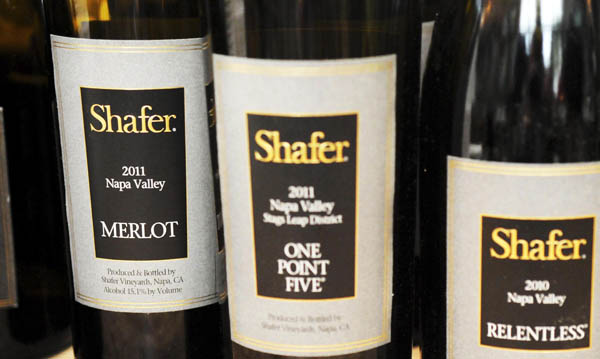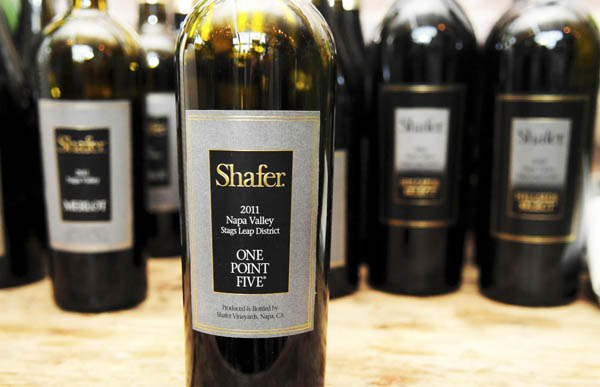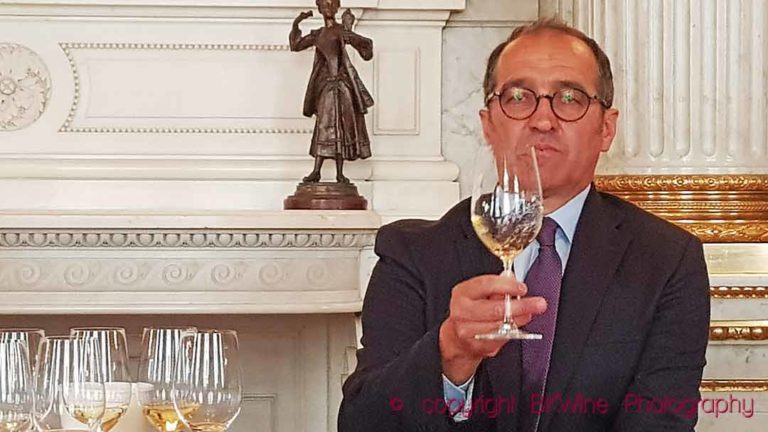Being Relentless – Shafer Vineyards’ Doug Shafer Shares his Views on Wine, Sideways, Hydrogen Sulphide, and How to Steal 300 Gallons of Excellent Cab to Make a Port
#2 of 5. John Shafer started Shafer Vineyards in 1974. In 1984 he was joined by his son Doug Shafer, who now runs the winery. BKWine’s Ulf Bengtsson met Doug Shafer over a wine tasting and lunch. In this second of five articles it is question of “that horrible move” Sideways, a catastrophic vintage, saved, and the politics of a famous name. Plus two more good wines.
This is the second of four in a series of articles on Shafer Vineyards. Read them all!:
- Shafer Vineyards (1/5): Becoming a winemaker, and Chardonnay 2012
- Shafer Vineyards (2/5): A catastrophic vintage and the mysterious Stags Leap, and 2011 One Point Five (this article)
- Shafer Vineyards (3/5): The quest for perfection and a talented winemaker
- Shafer Vineyards (4/5): Opening 9000 cases of merlot and cabernet
- Shafer Vineyards (5/5): Californian port, stolen grapes and terroir
2011 Merlot — and Sideways, that horrible movie
One of the sure things in life is that if you are a Californian winemaker with a rather large portion of merlot in your portfolio then there is virtually no practical way of avoiding a thorough discussion of the film Sideways and its implications. The subject seems to be rather unliquefiable, like a die-hard movie gangster. But since merlot sales plunged just because a movie character in a film said it wasn’t the thing to drink, we love the story! I can see Doug reaching for it, and I can see the rest of us, twenty people or so, sharpening our ears…
Shafer Vineyards has been making merlot since 1983. In California merlot used to be the blending grape. No one thought of making a wine solely of merlot; in large part it was used to soften the harsh tannins in the cabernet sauvignon. But in the early 1980s, as the interest for Californian wine and cabernet sauvignon in particular started to mature, many Californian winemakers sought a way to distinguish themselves with retailers and distributors. Especially on the East Coast and on the New York scene. Aiming at being the ones sticking out, coming with something new, Doug and John Shafer decided to make a wine with pure merlot. This worked out very well and others followed.
But since then Californian merlot has evolved into something rather bulky and cheapish. Doug recalls that in the mid-1990s you could go to a restaurant and the merlot section would be twenty merlots. The pinot noir section, by contrast, would maybe consist of just four pinots.
“I knew these merlots. I would say to the restaurants, you have this and this; these aren’t that good. And they would go, ‘but we gotta have ‘em ’cause people want merlot. Get what you expect.’ And now if you go to restaurants there are 25 pinots and four merlots! Sideways, you know, being a California guy, being an American and everything is rosy, what is the good thing? The good thing is… short term it was horrible. It killed merlot sales. Not internationally.”
“But the good thing was, merlot was so popular, these negociant winemakers, buying lousy merlot fruit, and lousy merlot bulk wine, bottling it and making hay. And when merlot is not good, trust me, it is bad. Weedy and green and thin wine. So all the negociants stopped making merlots, and they started making… lousy pinots. Hahaha! But now, in the long term, if anybody from California makes merlot chances are it is going to be a good wine. Because, otherwise, they’re out of the business. That’s my merlot story and I am sticking to it.”
Before me I have the 2011 merlot. It is fantastic. A real beauty, lots of ripe fruit, rich, lavish, scoring high on quaffability. I love this wine. The wines to come, especially Hillside Select, are also strikingly good – and most quaffable! – but there is something special in the merlot that appeals to me.

Doug continues about the 2011 vintage, a tough year. “Toughest I have seen in thirty years. Cold, tough set, low crop, cold season, rainy harvest, mould and fungus. I saw colours of mould I have never seen before. I was: ‘Hey Elias, you have to come and see this, it’s… orange!’ It was like Europe! I have a lot of respect for European wine makers. Can’t believe they still have their hair on.”
“I sent Elias out in early June because we could tell it was a short crop: ‘Find any grape you can and buy them!’ I didn’t see him for two weeks. All I got was texts: ‘I found two tons of cab franc up here. I found two tons of merlot here…’ One day he calls me up and says ‘I’ve found 20 tons of sauvignon blanc, what do you think?’ This is my winemaker. I tell him, ‘Look, we do not do sauvignon blanc!’ He goes, ‘Doug, you told me to find any grape!’ Thirty years, it is like we’re married… But the merlot blend is kind of funny. 75% merlot, 15% cab, 8% malbec, 2% petit verdot… and some sauvignon blanc! No, seriously…”
However, blending wine is not an easy task. Robert Parker, founder of The Wine Advocate, had allegedly hinted that they should put some viognier in their syrah. “When Parker tasted our syrah for the first time, he was so funny, he goes, ‘Hey, this is really good, but, how about some viognier in here?’ By this time we knew him pretty well. So we couldn’t stop ourselves from exclaiming, ‘Hey Bob, you’re asking a couple of Californian guys to put some white wine in a red wine? Well that aint going to happen!’ So that’s the merlot. We have been using the malbec in the merlot every year.”
2011 One Point Five — and the mysterious Stags Leap District
The next wine is Shafer Vineyards cabernet sauvignon, named One Point Five referring to the one and a half generations of winemaking that the Shafer family has lived through. Doug explains, “Dad started the business late, second career, I joined him early, so instead of two generations we have one and a half. Hence the name. That’s kind of cute. When we first released it we had some issues with warehouses, people thought they were ordering magnums… The name speaks of the family business; I sell wine by telling stories. If I start talking about pH and things like that people go ZZZ.” One Point Five is essentially cabernet sauvignon, blended with small amounts of petit verdot and malbec.
The Stags Leap District is famous for many things, the war of the apostrophes being one. One the one hand Stag’s Leap Wine Cellars, founded by Warren Winiarski, on the other Stags’ Leap Winery, established by Carl Doumani. In his book, A Vineyard in Napa, Doug Shafer notes that his father, John Shafer, did not have the stomach for legal battles and did not take sides. I am not going to dwell further on the clash, other than that it was peacefully settled in 1986 and the vintners eventually made a wine together. However, John Shafer did have a pivotal role in the creation of Stags Leap District, a sub-appellation (AVA) of Napa Valley. Because that is where the magic is.
John Shafer was born in 1924. He had had a successful career in the publishing business, ending up a corporate executive at Scott Foresman in Chicago. But there was something missing. No matter how much he worked at Scott Foresman, he could never become his own boss. There was too much corporate red tape, too much desk work. He longed for a job outdoors, getting his hands dirty.
In 1970 he read an article titled “Outlook for the California Wine Industry,” published by the Bank of America. In it, it was argued that wine consumption will dramatically increase the next ten years. Predictions held that US consumption would reach 400 million gallons by 1980 (actual figures turned out to be 480 million). More figures pointed this way. In Napa, between 1964 and 1969, the value of the annual grape harvest had soared from 2.9 million dollars to 8 million dollars. In other words, wine consumption was clearly on the move.
Then there was this itch to work outside, although his agricultural experience at this time amounted to tossing hay balls and growing flowers in the family back yard. He wanted to become his own boss, make something his own creation.
In the early 1970s, John Shafer started to read all about wine and wine growing. In 1972 he flew to California and scouted for vineyard sites. He looked at sites in Edna Valley, in Monterey, and in Santa Maria. At one point he talked to an old-timer who was surprised that he looked for wine locations in the southern part of California. “What are you doing down here?” he said. “There’s nothing happening here, you need to go to Napa!”
John Shafer then turned to Napa. There were lots of available sites in the centre of the valley, but the soil on the valley floor was too good. The mission was to find a dry, rugged hillside. This, since Bacchus amat colles. The God of Wine loves the hills.
After discussing various sites with real estate agents, John Shafer finally found a 209 acre site in Stags Leap District. It had been on the market for three years, and one could easily understand that is was no jewel. It was very steep, mostly volcanic soil. As much as three quarters of the total area was considered not possible to plant. But to John Shafer, it was perfect.
Common belief at the time however, was that the Stags Leap District was too cool for cabernet sauvignon. Most people argued that you needed to plant cab in the warmer areas of Napa, such as Rutherford or Oakville. The property that John Shafer bought was planted mostly with Zinfandel and Carignan, way past their prime.
As it turns out, perhaps due to that the Stags Leap District is a boxed canyon, and thus a cooler part of Napa Valley, the tannin structure of the wines from Stags Leap tend to be softer. The softness of the wines has been a topic for many discussions, all at some point leading to the question “How much merlot did you put in this?” The question has been asked candidly, as in “Dear Mr. Shafer, how much merlot did you put in this?” and clandestinely, as in “I swear to God I’m not going to tell ANYBODY but PLEASE, how much merlot did you put in this?”

So if you encounter a rich, opulent Californian cabernet with soft tannins, money is on that it is Stags Leap. The hallmark of Stags Leap District is essentially rich fruit, soft tannins, as opposed to other areas which may be more tannic, more masculine type of wine. Eighty-five per cent of the grapes have to come from that subarea for the wine to be labelled Stags Leap.
This is the second of four in a series of articles on Shafer Vineyards. Read them all!:
- Shafer Vineyards (1/5): Becoming a winemaker, and Chardonnay 2012
- Shafer Vineyards (2/5): A catastrophic vintage and the mysterious Stags Leap, and 2011 One Point Five (this article)
- Shafer Vineyards (3/5): The quest for perfection and a talented winemaker
- Shafer Vineyards (4/5): Opening 9000 cases of merlot and cabernet
- Shafer Vineyards (5/5): Californian port, stolen grapes and terroir
Ulf Bengtsson writes about wine under the pseudonym Red Scream on his blog Red Scream and Riesling, on wine, food, photography and other things that are important in life. Like detective novels, taking long walks in Stockholm and the occasional burst of exercise. He is also on Facebook.
[box type=”info” style=”rounded” border=”full”]BKWine organises wine tours, with wine tastings and winery visits, for wine lovers to many of the world’s wine regions but currently we do not offer any wine tours to California. Contact us if you are interested in a custom designed wine tour to California or to any other wine region in the world.
Travel to the world’s wine regions with the experts on wine and the specialist on wine tours.
The ultimate wine travel experience![/box]










3 Responses